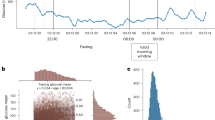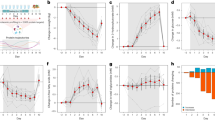Abstract
Objective:
To examine associations between dietary patterns and obesity.
Design:
Cross-sectional study.
Subjects:
A total of 3760 Japanese female dietetic course students aged 18–20 years from 53 institutions in Japan.
Measurements:
Diet was assessed over a 1-month period with a validated self-administered diet history questionnaire with 148 food items, from which 30 food groups were created and entered into a factor analysis. Body mass index (BMI) was calculated from self-reported body height and weight.
Results:
Mean BMI (±s.d.) was 20.9±2.8 kg m−2. Four dietary patterns were identified. After adjustment for several confounding factors and total energy intake, the ‘Healthy’ pattern, characterized by high intakes of vegetables, mushrooms, seaweeds, potatoes, fish and shellfish, soy products, processed fish, fruit and salted vegetables, was significantly associated with a lower risk of BMI⩾25 (odds ratio of the highest quintile vs lowest, 0.57; 95% confidence interval: 0.37–0.87; P for trend <0.05). In contrast, the ‘Japanese traditional’ pattern, characterized by high intakes of rice, miso soup and soy products, and the ‘Western’ pattern, characterized by high intakes of meats, fats and oils, seasonings, processed meats and eggs, were both significantly associated with an increased risk of BMI⩾25 (OR: 1.77; 95% CI: 1.17–2.67; P for trend <0.01 and OR: 1.56; 95% CI: 1.01–2.40; P for trend=0.04, respectively).
Conclusion:
Three major dietary patterns, Healthy, Japanese traditional and Western, were all independently and significantly related to the risk of obesity even among a relatively lean young Japanese female population.
This is a preview of subscription content, access via your institution
Access options
Subscribe to this journal
Receive 12 print issues and online access
$259.00 per year
only $21.58 per issue
Buy this article
- Purchase on Springer Link
- Instant access to full article PDF
Prices may be subject to local taxes which are calculated during checkout
Similar content being viewed by others
References
Willett WC . Is dietary fat a major determinant of body fat? Am J Clin Nutr 1998; 67 (3 Suppl): 556S–562S. Review.
Appleby PN, Thorogood M, Mann JI, Key TJ . Low body mass index in non-meat eaters: the possible roles of animal fat, dietary fibre and alcohol. Int J Obes Relat Metab Disord 1998; 22: 454–460.
Bray GA, Popkin BM . Dietary fat affects obesity rate. Am J Clin Nutr 1999; 70: 572–573.
Howarth NC, Huang TT, Roberts SB, McCrory MA . Dietary fiber and fat are associated with excess weight in young and middle-aged US adults. J Am Diet Assoc 2005; 105: 1365–1372.
Stookey JD . Energy density, energy intake and weight status in a large free-living sample of Chinese adults: exploring the underlying roles of fat, protein, carbohydrate, fiber and water intakes. Eur J Clin Nutr 2001; 55: 349–359.
Golay A, Allaz AF, Morel Y, de Tonnac N, Tankova S, Reaven G . Similar weight loss with low- or high-carbohydrate diets. Am J Clin Nutr 1996; 63: 174–178.
Newby PK, Muller D, Hallfrisch J, Qiao N, Andres R, Tucker KL . Dietary patterns and changes in body mass index and waist circumference in adults. Am J Clin Nutr 2003; 77: 1417–1425.
Newby PK, Tucker KL . Empirically derived eating patterns using factor or cluster analysis: a review. Nutr Rev 2004; 62: 177–203.
Kant AK . Dietary patterns and health outcomes. J Am Diet Assoc 2004; 104: 615–635. Review.
van Dam RM, Grievink L, Ocke MC, Feskens EJ . Patterns of food consumption and risk factors for cardiovascular disease in the general Dutch population. Am J Clin Nutr 2003; 77: 1156–1163.
Kerver JM, Yang EJ, Bianchi L, Song WO . Dietary patterns associated with risk factors for cardiovascular disease in healthy US adults. Am J Clin Nutr 2003; 78: 1103–1110.
Maskarinec G, Novotny R, Tasaki K . Dietary patterns are associated with body mass index in multiethnic women. J Nutr 2000; 130: 3068–3072.
Newby PK, Muller D, Hallfrisch J, Andres R, Tucker KL . Food patterns measured by factor analysis and anthropometric changes in adults. Am J Clin Nutr 2004; 80: 504–513.
Murakami K, Sasaki S, Okubo H, Takahashi Y, Hosoi Y, Itabashi M, The Freshmen in Dietetic Courses Study II Group. Association between dietary fiber, water, and magnesium intake and functional constipation among young Japanese women. Eur J Clin Nutr 2007; 61: 616–622.
Sasaki S, Yanagibori R, Amano K . Self-administered diet history questionnaire developed for health education: a relative validation of the test-version by comparison with 3-day diet record in women. J Epidemiol 1998; 8: 203–215.
Sasaki S, Ushio F, Amano K, Morihara M, Todoriki T, Uehara Y et al. Serum biomarker-based validation of a self-administered diet history questionnaire for Japanese subjects. J Nutr Sci Vitaminol 2000; 46: 285–296.
Science and Technology Agency. Standard Tables of Food Composition in Japan. The fifth revised edition. 2000. Printing Bureau, Ministry of Finance (in Japanese): Tokyo.
Okubo H, Sasaki S, Horiguchi H, Oguma E, Miyamoto K, Hosoi Y et al. Dietary patterns associated with bone mineral density in premenopausal Japanese farmwomen. Am J Clin Nutr 2006; 83: 1185–1192.
Ministry of Health and Welfare. Kokumin Eiyou no Genjou (Annual Report of the National Nutrition Survey in 2003). Ministry of Health and Welfare: Tokyo, 2005 (in Japanese).
Matsuzawa Y, Inoue S, Ikeda Y, Sakata T, Saito Y, Sato Y et al. The judgment criteria for new overweight, and the diagnostic standard for obesity. Obes Res 2000; 6: 18–28 (in Japanese).
Food and Agriculture Organization/World Health Organization/United Nations University (FAO/WHO/UNU). Energy and Protein Requirements Report of a Joint FAO/WHO/UNU Expert Consultation. Technical Report Series No. 724. WHO: Geneva, 1985.
Ministry of Health, Labour, and Welfare, Japan. ‘Dietary Reference Intakes for Japanese, 2005’. Daiichi Shuppan Publishing Co. Ltd.: Tokyo, 2005 (in Japanese).
SAS Institute Inc. SAS/STAT User's Guide, version 6, 4th edn, vol. 2. SAS Institute Inc.: Cary, NC, 1989.
Willett WC . Implications of total energy intake for epidemiologic analysis. In: Willett WC (ed). Nutritional Epidemiology, 2nd edn. Oxford University Press: New York, 1998.
Kim J-O, Mueller CW . Factor Analysis: Statistical Methods and Practical Issues. Sage Publications Inc.: Thousand Oaks, CA, 1978.
Murakami K, Sasaki S, Takahashi Y, Okubo H, Hosoi Y, Horiguchi H et al. Dietary glycemic index and load in relation to metabolic risk factors in Japanese female farmers with traditional dietary habits. Am J Clin Nutr 2006; 83: 1161–1169.
Togo P, Osler M, Sorensen TI, Heitmann BL . Food intake patterns and body mass index in observational studies. Int J Obes Relat Metab Disord 2001; 25: 1741–1751. Review.
Murakami K, Sasaki S, Okubo H, Takahashi Y, Hosoi Y, Itabashi M, The Freshmen in Dietetic Courses Study II Group. Dietary fiber intake, dietary glycemic index and load, and body mass index: a cross-sectional study of 3931 Japanese women aged 18–20 years. Eur J Clin Nutr 2007; 61: 986–995.
Lin H, Bermudez OI, Tucker KL . Dietary patterns of Hispanic elders are associated with acculturation and obesity. J Nutr 2003; 133: 3651–3657.
Randall E, Marshall JR, Graham S, Brasure J . High-risk health behaviors associated with various dietary patterns. Nutr Cancer 1991; 16: 135–151.
Kerver JM, Yang EJ, Bianchi L, Song WO . Dietary patterns associated with risk factors for cardiovascular disease in healthy US adults. Am J Clin Nutr 2003; 78: 1103–1110.
Bostrom G, Diderichsen F . Socioeconomic differentials in misclassification of height, weight and body mass index based on questionnaire data. Int J Epidemiol 1997; 26: 860–866.
Villanueva EV . The validity of self-reported weight in US adults: a population based cross-sectional study. BMC Public Health 2001; 1: 11.
Nakamura K, Hoshino Y, Kodama K, Yamamoto M . Reliability of self-reported body height and weight of adult Japanese women. J Biosoc Sci 1999; 31: 555–558.
Wada K, Tamakoshi K, Tsunekawa T, Otsuka R, Zhang H, Murata C et al. Validity of self-reported height and weight in a Japanese workplace population. Int J Obes (Lond) 2005; 29: 1093–1099.
Hedley AA, Ogden CL, Johnson CL, Carroll MD, Curtin LR, Flegal KM . Prevalence of overweight and obesity among US children, adolescents, and adults, 1999–2002. JAMA 2004; 291: 2847–2850.
Ogden CL, Yanovski SZ, Carroll MD, Flegal KM . The epidemiology of obesity. Gastroenterology 2007; 132: 2087–2102. Review.
Livingstone MB, Black AE . Markers of the validity of reported energy intake. J Nutr 2003; 133 (Suppl 3): 895S–920S.
Martinez ME, Marshall JR, Sechrest L . Invited commentary: factor analysis and the search for objectivity. Am J Epidemiol 1998; 148: 17–21.
Acknowledgements
This work was supported in part by Grant-in-Aid for Young Scientists (Start-up) (18800049) from Japan Society for the Promotion of Science; and the Ministry of Health, Labor and Welfare, Comprehensive Research on Cardiovascular and Life-Style Related Diseases.
Author information
Authors and Affiliations
Consortia
Corresponding author
Rights and permissions
About this article
Cite this article
Okubo, H., Sasaki, S., Murakami, K. et al. Three major dietary patterns are all independently related to the risk of obesity among 3760 Japanese women aged 18–20 years. Int J Obes 32, 541–549 (2008). https://doi.org/10.1038/sj.ijo.0803737
Received:
Revised:
Accepted:
Published:
Issue Date:
DOI: https://doi.org/10.1038/sj.ijo.0803737
Keywords
This article is cited by
-
Association of dietary patterns with general and central obesity among Chinese adults: a longitudinal population-based study
BMC Public Health (2023)
-
Metabolic and enzymatic elucidation of cooperative degradation of red seaweed agarose by two human gut bacteria
Scientific Reports (2021)
-
The association between dietary patterns with severity of coronary artery stenosis, serum leptin-to-adiponectin ratio, and some related risk factors in patients with coronary artery disease
Journal of Diabetes & Metabolic Disorders (2021)
-
Food insecurity is associated with lower adherence to the Mediterranean dietary pattern among Lebanese adolescents: a cross-sectional national study
European Journal of Nutrition (2020)
-
Is the hedonic hunger score associated with obesity in women? A brief communication
BMC Research Notes (2019)



